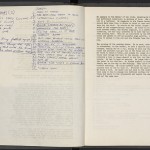
Ethan de Seife is an independent scholar and the author of the book Tashlinesque: The Hollywood Comedies of Frank Tashlin. He is currently an arts writer for the Burlington, Vermont, alternative weekly newspaper Seven Days. His research was supported by a Ransom Center travel grant. The Ransom Center is celebrating the 25th anniversary of its fellowship program in 2014–2015.
The best-known cinematic collaboration between actor Robert De Niro and director Brian De Palma is surely the 1987 film The Untouchables, in which De Niro memorably portrays a bloated, vengeful Al Capone. But the two artists have a shared history that goes back to 1968, when De Niro was a raffish young actor in New York’s off-off-off-Broadway theater scene, and De Palma, fresh from Sarah Lawrence’s ambitious film program, was a director whose head was filled with visions of the French New Wave, Alfred Hitchcock, and avant-garde weirdness.
To my mind, De Palma is the most talented of the directors of the so-called “Film School Generation.” He’s also the most misunderstood: critical writing on his work has been stuck in the same ruts (Hitchcock, violence, misogyny) since the 1970s. It’s getting boring. A filmmaker as gifted as he is deserves better.
In the first of what I hope are several archival expeditions in preparation for a book-length re-evaluation of De Palma’s work, I visited the Ransom Center on a travel grant in January 2014 to comb through the Robert De Niro papers. The two men made three unusual and fascinating films together before “reuniting” for The Untouchables: Greetings (1968), The Wedding Party (1969), and Hi, Mom! (1970). These three titles represent the earliest feature films of both of these artists, each of whom would very soon go on to much greater fame.
It was a good first choice for this project, as the artists’ shared body of work is pretty small and is mostly confined to early in their careers. I’d hoped to find some information on De Palma’s working methods, though this was not really in evidence. (Memo to the Ransom Center: Please solicit and archive the papers of Brian De Palma.) A few handwritten script notes did offer tantalizing clues, though.
The film Hi, Mom! is a vicious satire of Vietnam-era politics and liberal empty-headedness; it remains one of the most subversive of all American films. Much of its deserved reputation for challenging satire rests on the infamous “Be Black, Baby” sequence, in which the members of a black radical group stage a work of participatory theater designed to allow white people to “experience” blackness. Patrons are subjected to all manner of abuse… and then rave about the show. It’s a deeply ambiguous and still pretty shocking scene.
De Niro’s own notes for this scene are, in total: “At ‘Be Black, Baby’ play where I play a cop and beat up the white liberals painted black.” The paucity of this description itself speaks to the importance of improvisation to both De Niro’s and De Palma’s art; this, in turn, reveals a great deal about the nature of the film’s production.
The most intriguing of my finds in the De Niro papers pertains to a De Palma film in which De Niro does not even appear. De Palma made Home Movies in 1980 in an unprecedented collaboration with film students at Sarah Lawrence. In the collection was a treatment (a kind of synopsis) of the script dated from 1970; apparently De Niro had been considered for a part in it. The treatment differs in significant ways from the film as it was made a decade later, and those differences themselves may also prove revelatory of De Palma’s evolution as an artist.
Once I’d exhausted the parts of the De Niro papers that pertain to De Palma, I moved on to two other Ransom Center collections that, coincidentally, also overlap with De Palma’s career: the papers of playwright and screenwriter David Mamet and that of screenwriter Paul Schrader. The former wrote The Untouchables and the latter wrote De Palma’s 1976 film Obsession.
The Mamet papers offered mostly old marked-up scripts, which would have been useful had the object of my quest been Mamet’s writing methods. The Schrader papers, though, yielded a few gems, including a usefully comprehensive compendium of reviews of the film, collated by the writer’s clipping service. A few financial documents also provided potentially valuable clues about the film’s budget and production methods.
A few snapshots of promotional ephemera from Greetings allowed me to put a fun capstone on my perusal of the De Niro papers, to which I returned when time allowed on the last day of my brief residency. Had I wanted to don the “fat suit” that Robert De Niro wore in The Untouchables, I think I might have been able to arrange it. Maybe on my next visit.
Please click on thumbnails below to view larger images.

